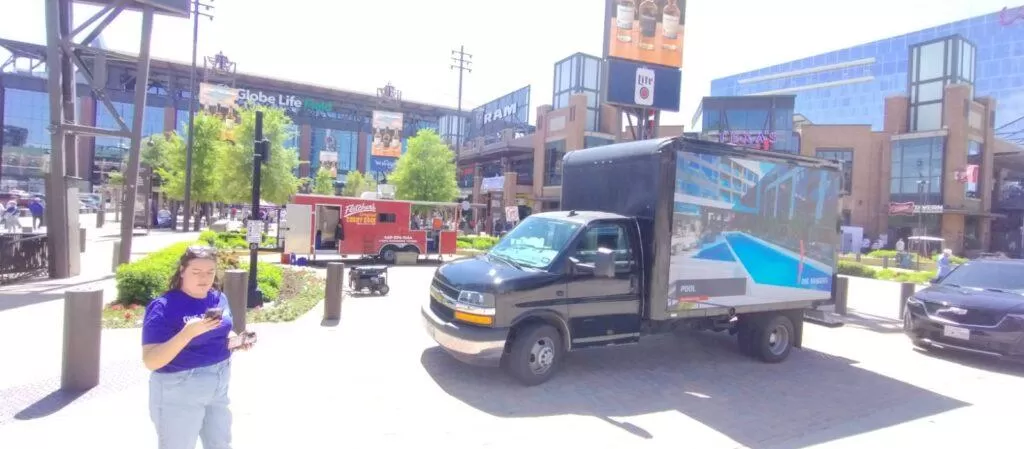In marketing and advertising, every decision you make can propel your brand forward or even worse hold it back. When it comes to advertising methods, like truck and bus ads there’s a lively debate about which one is more effective. Both approaches have their strengths so choosing the fit for your brand requires thoughtful deliberation.
Truck ads stand out due to their visibility and mobility while excelling at capturing attention. As trucks travel through streets and highways they serve as billboards that display your brand. In contrast, bus ads transform public transport vehicles into moving ads enabling you to connect with customers as they go about their daily activities or enjoy leisure time.
Let’s explore the benefits and limitations of each choice. Whether you’re focused on boosting visibility and adaptability or aiming for an impact our goal is to help you decide which advertising platform aligns best with your brands goals.
Truck Advertising Explained

Truck advertising, commonly known as mobile billboard advertising, includes showcasing a brand’s ads, on the sides or back of trucks. These trucks travel along set routes catching the eyes of pedestrians on streets, highways and urban areas. One key benefit of truck advertising is its effectiveness in introducing brands to audiences.
Truck Advertising Benefits
Truck advertising offers an array of advantages. This strategy has been a player in the realm of advertising for quite some time thanks to its presence and flexibility. Serving as billboards that travel through locations, truck advertising provides a powerful avenue for brands to deliver a compelling message and engage with fresh audiences.
- Increased Visibility: Placing an advertisement on a truck is sure to attract attention. Opting for this advertising approach guarantees that your brand will stand out. The size of trucks ensures that your ad can easily become a point of recognition for both drivers and pedestrians.
- Targeted Marketing: Brands prefer truck advertising, for its ability to target areas where their target audience is likely present. This precision ensures that your advertising budget is effectively utilized, reaching the people you want to reach thus maximizing both impact and investment.
- Versatility: Truck advertising provides the flexibility to reach audiences in settings from city streets to quiet suburban roads. Unlike billboards, trucks can move around to spread your message across demographics and locations expanding your brand’s outreach.
- Cost Effectiveness: Compared to the costs associated with billboards, truck advertising proves to be a cost effective option. Opting for billboards allows you to get value for your advertising budget without the commitments and higher expenses linked with static ads.
Read Also: How Billboard Advertising Boosts Your Brand: A Closer Look
Negatives of Truck Advertising

In our current market environment making sure that every advertising dollar is well spent is absolutely a must. Therefore it’s important to have an understanding of both the positives and negatives of truck and bus advertising. While truck advertising typically excels, in visibility and flexibility it does come with its set of challenges.
Factors like targeting options and potential environmental impacts are aspects that companies should carefully think about before fully committing to truck advertising. We will explore these considerations below providing insights into how they could impact your advertising budget and the overall success of your brand.
- The targeting options of trucks can be limited due to their fixed routes making it challenging to reach demographics or locations precisely.
- In areas with population density advertisements on trucks face tough competition from other vehicles, billboards and digital ads. This intense competition may lessen the effectiveness of advertising efforts.
- Truck advertising could be a concern for brands and customers focused on sustainability because of the carbon footprint associated with vehicle ads, which could deter conscious consumers.
- The live nature of truck ads means that messages are only seen briefly. Unlike billboards that offer exposure, moving ads may struggle to capture and maintain attention effectively potentially reducing the impact of the advertising message.
Read Also: Mobile Billboard Advertising vs. Traditional Marketing Channels: A Comparison
Bus Advertising Explained

Placing brand advertisements on buses both inside and outside turns these vehicles into moving billboards that display your message. Buses play a role in transportation in populated areas as well as less crowded regions providing brands with a great chance to reach out to diverse audiences.
Advantages of Bus Advertising
Bus ads transform commutes into a stage for your brand to tell its story and draw in potential customers. With a host of benefits it’s a choice for marketers looking to increase their visibility and connect with audiences.
Opting for this advertising avenue involves turning buses into billboards that catch the eye of commuters and pedestrians alike. The key to marketing here is the exposure you gain by turning buses into a prime platform for your brand to interact with a wide range of people, on a regular basis.
- Captivating Audiences: The prolonged duration that passengers spend aboard buses creates a chance for your brand to leave a lasting impression. Whether, during their commute or while out with friends travelers are perfectly positioned to take notice of and engage with bus ads.
- Community Centric Approach: Since buses follow routes within areas tailoring your advertising efforts to target neighborhood residents becomes seamless. This allows you to create messages that directly resonate with the characteristics and preferences of communities.
- Increased Visibility: Bus ads excel in providing passengers with opportunities to view your advertisement for those who frequently travel along the same route. This consistent exposure aids in ingraining your brand in consumers minds fostering a brand connection.
- Environmental Sustainability Edge: For brands seeking eco consumers bus advertising emerges as a sustainable option. By utilizing existing public transportation infrastructure for advertising purposes you avoid contributing emissions that would result from vehicles on the road.
Downsides of Bus Advertising
When you’re deciding on where to invest your budget for advertising, on buses it’s important to look at both perspectives. Let’s go into some of the drawbacks that come with this type of advertising which are similar to the constraints seen in truck advertising.
While bus ads offer a way to reach audiences as they move around the city there are some challenges to consider. Factors like visibility, in quieter areas and space constraints should be taken into account before starting a bus ad campaign.
- Limited Reach: Bus routes mainly cover cities and suburbs making it harder for brands to reach customers in areas through bus advertising.
- Visibility Challenges: Adverse weather, traffic issues and route changes can impact how well your ads are seen on buses. These factors may reduce exposure and lower the effectiveness of your ad campaign.
- Space Limitations: The unique designs of buses can affect where and how you place your ads. Those wanting to use ads may face difficulties due to space constraints on buses.
- Attention Competition: Grabbing the attention of bus passengers is tough, with distractions. Passengers often use their phones making it harder to stand out with your ad and make an impression.
Read Also: Mobile Billboard Advertising Trends to Watch in 2024
Choosing the Best Advertising Method for Your Brand
Choosing between advertising, on trucks or buses requires thought about a few factors. To decide which advertising method suits your brand best think about the following questions;
- Who is your target audience? Consider where they spend most of their time and what their demographics are. Knowing where your audience is likely to see and engage with your ads is one of the most important steps.
- How far reaching do you want your ads to be? Do you want visibility across areas or are you focusing on a specific community? Determining the scope of your ad campaign can help you pick the advertising medium that will give your brand exposure.
- What is your advertising budget? Figure out how much you can afford to spend on advertising. Can you accommodate both truck and bus advertising within your budget? Do you have to choose one option? Identifying which choice fits within your limits is key.
- Is your message more suited for trucks or buses? Think about whether the format of a truck or bus aligns, with the message you want to convey in your ads. Understanding your message clearly will help decide which medium can effectively communicate to your target audience.
When you carefully weigh the pros and cons of advertising, on trucks and buses you’ll have a tough time deciding which option best suits your brand’s requirements. Taking the time to make this decision ensures that you are making a thought out choice optimizing the returns on your investment in terms of both money and effort.
Considering factors like target audience demographics, budget limitations and the message’s nature is very important, before committing to either method. Luckily both advertising approaches offer advantages that can effectively reach your desired audience.
When deciding between utilizing truck advertisements and bus advertisements the choice becomes more evident once you consider the factors at play. This choice will guide you towards improving your brand’s visibility, drawing in clientele and standing out in a market. Here’s to increasing your brand’s visibility and to making your advertising campaign worthwhile.
Read Also: How Your Business Can Get Noticed with Billboard Trucks



